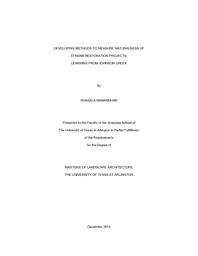
ATTENTION: The works hosted here are being migrated to a new repository that will consolidate resources, improve discoverability, and better show UTA's research impact on the global community. We will update authors as the migration progresses. Please see MavMatrix for more information.
Show simple item record
| dc.contributor.author | Manandhar, Nhasala | en_US |
| dc.date.accessioned | 2013-03-20T19:12:32Z | |
| dc.date.available | 2013-03-20T19:12:32Z | |
| dc.date.issued | 2013-03-20 | |
| dc.date.submitted | January 2012 | en_US |
| dc.identifier.other | DISS-12018 | en_US |
| dc.identifier.uri | http://hdl.handle.net/10106/11610 | |
| dc.description.abstract | The purpose of this research is to develop methods to assess the naturalness of restored stream environments by studying user perceptions and preferences in the Johnson Creek project in the Dallas and Fort Worth (DFW) metropolitan area. This research specifically concentrates on measuring three indicators of naturalness: greenness, openness, and visual access to water as they are recognized to be critical in components of naturalness in pertinent literature (Hepcan et al., 2004; Dramstad et al., 2006; Kaplan and Kaplan, 1978). This research also examines the suitability of geographic information system (GIS) tools to measure naturalness in order to conduct similar studies without on-site surveys. Streams are not just an urban infrastructure but also part of an ecosystem (Pinkham, 2001). Restored stream corridors can also be a significant component of a green and open spaces network for pedestrians in metropolitan areas. The re-introduction of such environments to green infrastructure in DFW is especially critical due to limited availability of such natural assets near densely populated urban areas (North Texas 2050, 2010). However, in order for such places to be a desired space for people to inhabit, the naturalness referred to must be a preferred attribute of design. Although literature emphases the presence of nature as a determinant in users' participation in such environments, there are limited numbers of reliable methods to measure naturalness especially in stream environments in urban settings. This research uses quantitative methods, in the form of an on-site walkthrough survey, to measure user perception of naturalness; greenness, openness, and visual access to water. The research also utilizes geographic information system (GIS) (see also Holtan, 2012) tools to measure the presence of these three components of naturalness in restored stream environments. A segment of Johnson Creek has been chosen as the study site due to its recent restoration and its relevant importance for the greenness, open space and visual access to water for the potential users of the area. In conclusion, the result illustrates that all three components studied in this research seem to be present in the study location, but users preference of greenness, openness, or visual access seem to vary from one data collection point to the other. Research also illustrates that GIS findings were similar to users ratings of the presence of the three factors in the on-site survey, illustrating that GIS has certain limited capabilities to provide reliable tools that can be used to assess the presence of nature in restored stream environments. Research also illustrated that users' preference of greenness, openness, or visual access seem to correlate with the presence of these attributes in most cases, but the preference responses vary from one data collection point to the other. | en_US |
| dc.description.sponsorship | Ozdil, Taner R. | en_US |
| dc.language.iso | en | en_US |
| dc.publisher | Landscape Architecture | en_US |
| dc.title | Developing Methods To Measure Naturalness Of Stream Restoration Projects: Learning From Johnson Creek | en_US |
| dc.type | M.L.A. | en_US |
| dc.contributor.committeeChair | Ozdil, Taner R. | en_US |
| dc.degree.department | Landscape Architecture | en_US |
| dc.degree.discipline | Landscape Architecture | en_US |
| dc.degree.grantor | University of Texas at Arlington | en_US |
| dc.degree.level | masters | en_US |
| dc.degree.name | M.L.A. | en_US |
Files in this item
- Name:
- Manandhar_uta_2502M_12018.pdf
- Size:
- 7.209Mb
- Format:
- PDF
This item appears in the following Collection(s)
Show simple item record


